I thought I'd take a step back this week and paint a a landscape perspective of regenerative agriculture. There are a few core principles that are present to some degree on every regenerative farm. Imagine these principles as layers that each contribute to the overall health of the ecosystem.
Layer 1: soil microbial complexity
Layer 2: plant diversity
Layer 3: grazing cadence
As we go, I'll compare each layer to practices in conventional agriculture to help offer perspective.
Layer 1: Soil Microbial Complexity
Soil is teeming with life. There are more microorganisms in a teaspoon of healthy soil than human beings alive on earth. This microbial life in the soil takes the inputs from sun, rain, and manure and turns these inputs into energy for plants. Regenerative agriculture seeks enhance the symbiotic relationships between the microbial life and the plants fostering an environment where this complex web of life will thrive.
This perspective is in contrast to conventional agriculture where microbial complexity in the soil is either minimized or eliminated. Tillage is a prime example of this.
People don't realize how destructive tillage is. The loose soil is left exposed to wind and water erosion, and the bare ground is inefficient at absorbing rain droplets. Worst of all, when the soil is turned over, it kills the anaerobic life which is typically below 5 inches of soil by exposing it to oxygen. Simultaneously, tillage buries the aerobic life deep in the soil away from oxygen. By killing the microbial life, tillage reduces the plant's ability to synthesize energy jeprodisring the symbiotic relationships.
In an untilled healthy ecosystem, the plant roots penetrate deep into the soil bringing the nutrients that anaerobic life needs, and earthworms and dung beetles burrow close to the surface aerating the soil where the aerobic life thrives.
Layer 2: Plant Diversity
This second layer is all about keeping the soil covered with a diverse array of plant life. Bare ground is an enemy to the microbial life in the soil. A thick covering of plants keeps the symbiotic relationships alive and well. Leaf matter also reduces the temperature of the soil and provides a buffer to soften the blow of rain droplets.
Just as plants need the complex microbial life, the microbial life needs the plants. Some plants fix nitrogen out of the atmosphere, some spread quickly and cover the soil, and some send roots deep into the ground, all while contributing to the overall health of the ecosystem.
Most conventional practitioners don't understand the symbiotic relationships the plants and microbial life have, and leave fields void of plants for many months of the year. Even when crops are planted, they are one variety alone. This mono-cropping doesn't offer the variety necessary for healthy symbiotic relationships and increases the plants susceptibility to disease.
Regenerative agriculture seeks to find balance in the ecosystem by maintaining a diverse array of plant life to keep the soil surface covered.
Layer 3: Grazing Cadence
The addition of grazing livestock allows a regenerative farmer to effectively manage the health of the first two layers. Livestock are efficient at converting the energy captured in plants into a dense and nutritious energy source for humans. And it is through this energy conversion that they provide a critical fertility component back to the soil. Urine and manure are the spawning grounds for the decomposition of plant matter that will eventually feed the microbial life in the soil.
It is through a careful grazing cadence that grasslands are kept healthy. Moving livestock based on the rate of plant growth ensures that a plant has time to recover. When a plant is grazed, the root dies basically in proportion to the amount of forage taken above ground. Now, this alone isn't a bad thing. The dead root structure decomposes creating more organic matter in the soil.
The problem arises when the plant begins to regrow and livestock are allowed to graze that plant before it has matured. This stifles the nutrient cycle making it difficult for the symbiotic relationship between plant and microbial life to function.
This crippling of new growth is a common practice in conventional agriculture where livestock are left to roam large areas of land for long periods of time. They selectively graze for the fresh new growth eventually killing sensitive plants and increasing the amount of bare ground.
Regenerative agriculture uses simple electric fences to keep livestock moving over the pasture in an organized cadence. Plants are left to recover, and the whole ecosystem is healthier for it.
These 3 layers are the basic principles undergirding regenerative agriculture. Not only does this approach ensure health for the ecosystem to maintain itself, it builds resiliency for the long-term. Building soil health, or "regenerating" the soil can be accomplished without the use of expensive inputs or sophisticated equipment. The farmers who do this best are just observant and thoughtful stewards of the land they have.

